BY ADAM GAVINE ON JULY 8, 2019 AIRCRAFT INTERIORS INTERNATIONAL
Even 25 years after the B777 was first unveiled, it is still a hard act for the Boeing design team to follow. When it was revealed to the world in June 1994 it was the first computer-designed airliner, the first fly-by-wire airliner, and as the aircraft proved itself in service, it has proved a commercial success, with more than 1,500 delivered to date. There is a lot of love for the triple-seven, from airlines, crew and passengers alike.
The B777 had another interesting first, being the first Boeing cabin design to be created with significant input from airlines, and this is where the B777X cabin design story begins. However, airline customers put a little more pressure on the Boeing team this time round.
Kent Craver, Boeing’s regional director of cabin experience and revenue analysis, recalls the airline feedback at the beginning of the project: “You had a great breakthrough with the Dreamliner cabin interior. You need to do it again with the B777X. The B777 cabin is good, the B787 is great, but the B777X needs to be even better.”
The B777X cabin is wider, more attractive and more high tech – and dare we say ‘better’ – than its predecessor’s cabin, but the real benefit for airlines is its much wider scope for customization, which can be achieved simply and quickly, with the cabin serving as a blank canvas for airline customers to express their brand.
“The 777 cabin is pretty tough to beat,” agrees PJ Wilcynski, payloads chief architect, senior technical fellow and 39-year veteran at Boeing. “But with the 777X, we have taken the architecture to the next level.”
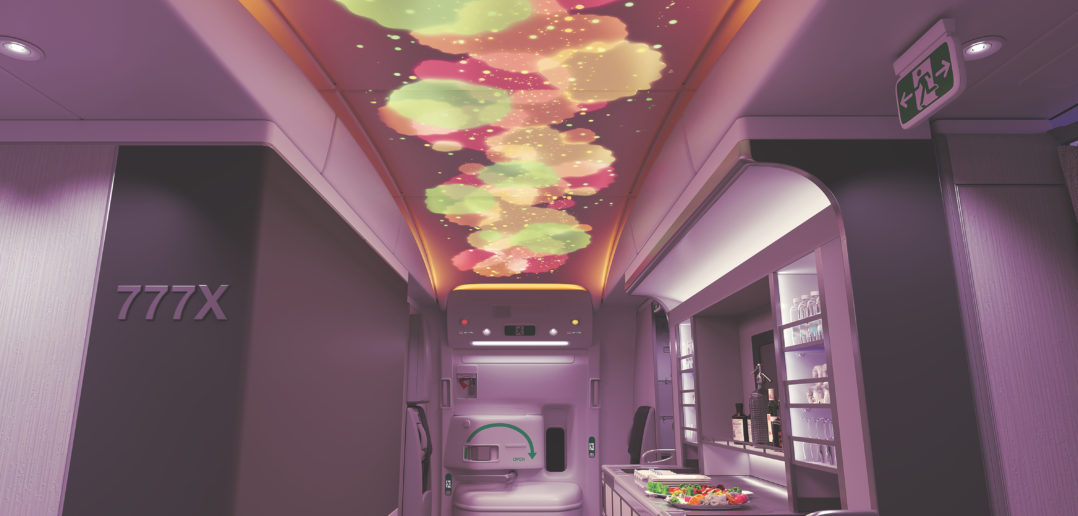
A broad, blank canvas
The cabin design is an application of Boeing’s Sky Interior philosophy, a holistic approach that brings together every aspect of the cabin, with visual aspects such as the architecture, lighting, stowages, ceilings and sidewalls working in harmony with technologies such as pressurization, air filtration and humidity systems, and Smooth Ride Technology features to create a considered and cohesive passenger experience.
That philosophy is applied differently on every platform and optimised for the different cabin sizes. Indeed, cabin size is a major aspect of the B777X, with the aircraft having a gain in cabin width over the B777, despite having the same external fuselage cross-section.
By redesigning the sidewalls and fitting thinner insulation, internal cabin width has been carved out from the 231in (587cm) of the B777-300ER, to 235in (597cm). Four inches may not sound like much, but it represents a significant engineering and design effort, and that extra width gives airlines more design flexibility and scope for expression – something that airline customers have indicated to Boeing that they want.
Further design flexibility for airlines is enabled by the cabin linings options that have been developed for B777X. The various packages give airlines more choices for customising their cabin designs, with multiple options for sidewalls, ceiling treatments, stowage bin treatments, and bin options – whether the customer wants big bins, small bins or no bins.
Removing the centre bins from business and first class cabins has become an increasingly popular design trend, enabled by the greater internal stowage of many seats. However, creating a ceiling design that worked in that space wasn’t always easy, adding time, cost and complexity to a project. In response, Boeing added a premium ceiling option for the B777 to simplify the process. However, with the B777X’s variable architecture, it is as easy as selecting the required overhead stowage option and then selecting a preferred ceiling from a choice of two, one tapering outward the other inward. The linings packages are also designed to be quick and easy to install.
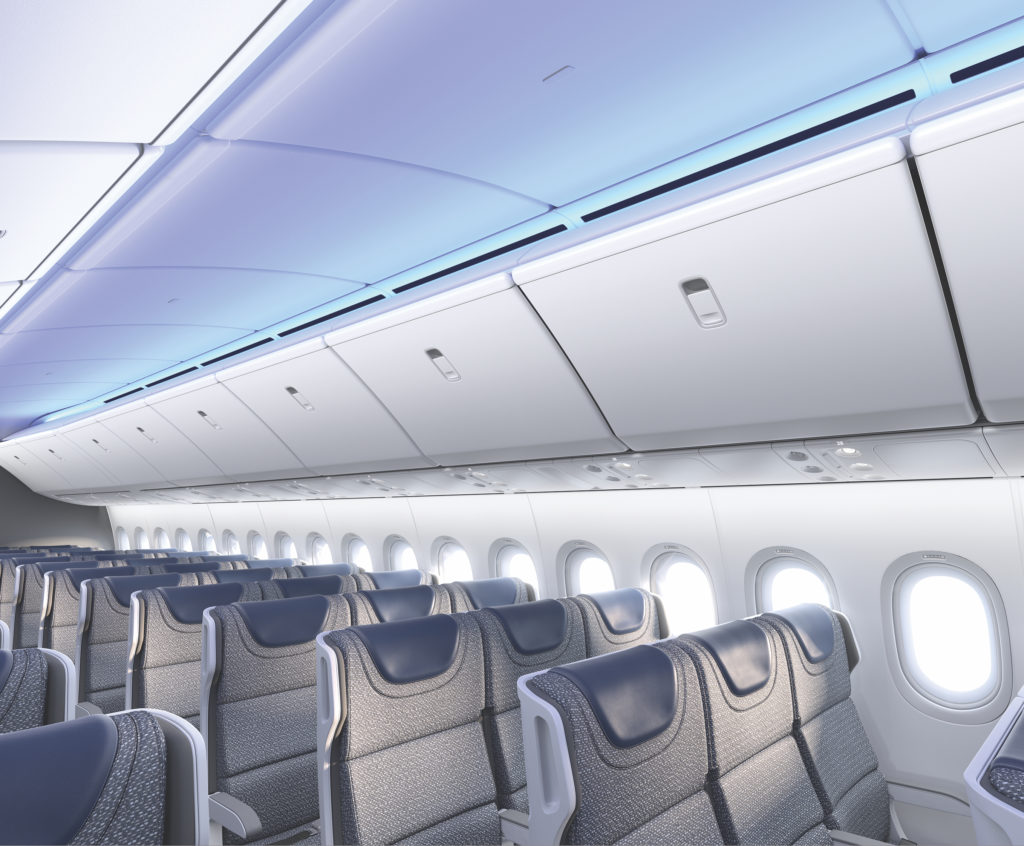
Craver states, “For me, as a former airline guy [he was previously manager of onboard product marketing and research at Continental Airlines], having premium style options that aren’t true custom options is huge because it gives you a lot of flexibility without having to spend a lot of resources in terms of money and engineering, etc, in getting them on to the aircraft. The goal is to remove as much complexity as possible to make it a simpler, lighter, easier more flexible process.”
Even better, different interior options can be specified for different cabins on the same aircraft, enabling customers to customise stowage in each cabin and create distinct architectural differences between classes.
As Craver explains, “Airlines can also have one ceiling treatment in one part of the aircraft and a different ceiling treatment in a different part, with a design cohesion that sees the spaces seamlessly transition from one to the other very elegantly, enabling airlines to specify different linings packages to differentiate each class, with a holistic design philosophy that ties it all together, with lighting, linings, bins ceilings, everything working together as a system.”
Blake Emery, Boeing’s director of differentiation strategy is excited by the possibilities. “With these additional options, we are just as excited as anyone else to see what the airlines choose to do with them, because it’s possible that every time you get on a B777X the experience might be a little different. If you push it to the extreme, an airline could potentially have four different bin and ceiling treatments in the same airplane. I personally doubt that any airline is going to go to that extreme, but that’s the kind of possibility that’s been opened up.”
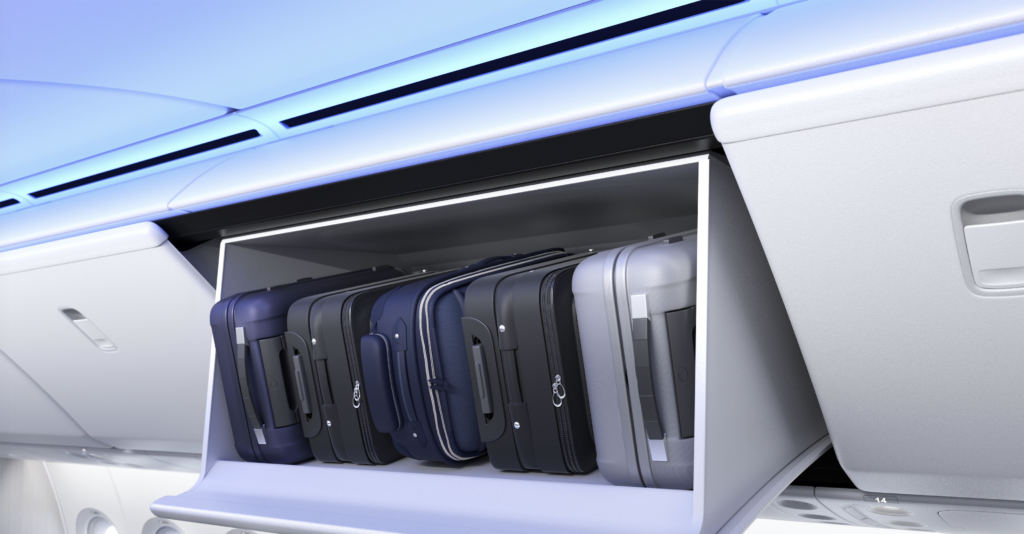
The proposed B777X stowage bin design. A fully laden stowage bin will require 40% less force to lift than with the outgoing B777 units
Stowages
The overhead bins are a major part of the architecture, and one of the most noticeable design enhancements. The doors have been resculpted to be concave rather than the typical convex shape, which really gives a greater feeling of space. It is a clear visual enhancement, but Boeing checked this by getting feedback from 4,000 people, and the overriding response was that they were surprised at how much more spacious the cabin felt with concave bins.
The capacity of the standard bins is the same capacity as those in the B787, designed to accommodate one roll-on bag per passenger. This is double the capacity that the first B777 flyers had available in the 1990s (although the roll-on bag wasn’t so common then), and another interesting statistic is that the B777X bins take 40% less effort to close when loaded than today’s B777 bins.
The concave form of the bins also works well with the ceilings to enable the cabin lighting to work to its best, accentuating the attractive architecture and enhancing the sense of space. The sculpted forms of the cabin become a canvas for the millions of lighting scene options, easing transition across the stages of a flight and time zones, with finely tuned LED lighting arrays washing over every surface with cascading and dynamic illumination effects.
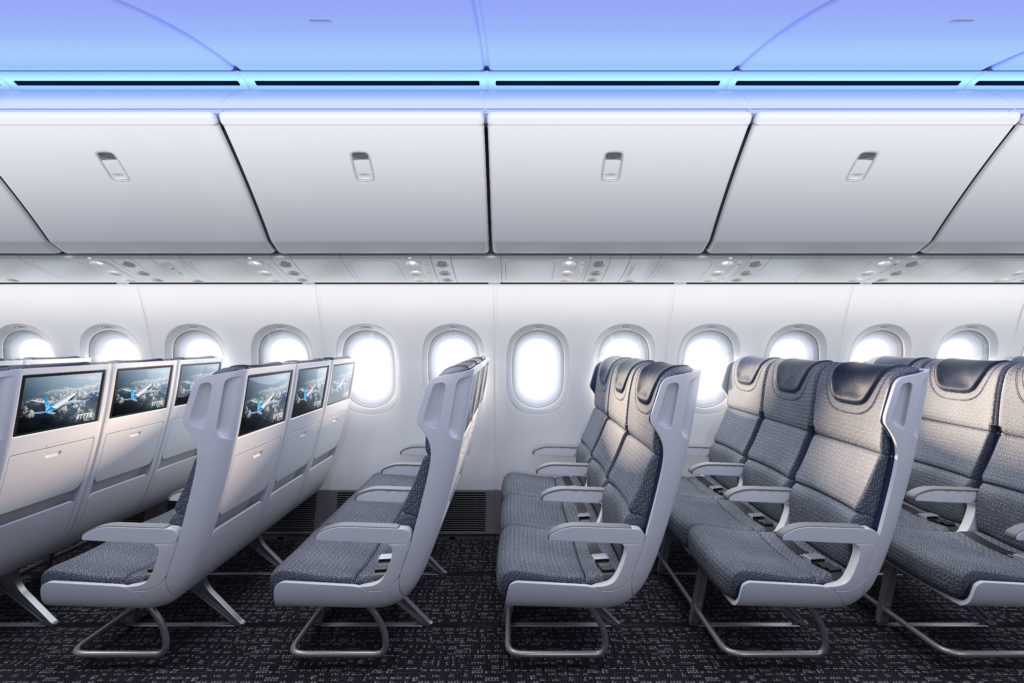
A rendering of a proposed economy class cabin for the Boeing 777X
Windows
The windows are for many the star attraction in a cabin, portals to the wonder of flight, not to mention being important to Boeing’s customer satisfaction and preference levels for aircraft types. With this in mind, the windows of the B777X are large enough to give everyone on board the benefit, and raised by 2.5in to provide a better view outside to passengers in the centre of the cabin, giving them a greater connection to sky.
As Wilcynski says, “Every seat becomes a window seat.”
The 162 square inch windows are much larger than the B777’s 140 square inch units, in response to the positive public reception to the B787’s large windows. However, while the B787’s large windows were enabled by the composite fuselage, this was more difficult to achieve in the B777X’s aluminium fuselage.
The technical details of how this was achieved are under wraps, with Wilcynski only stating that “trades were made”. It would be fascinating to find out the secret, especially as the aluminium tube has also been engineered to offer air humidity and higher cabin pressurisation to match the Dreamliner experience.
Naturally the B777X has a range of window options, with standard mechanical window shades, and options including dimmable windows, and treatments for first class similar to the stylish double window found on British Airways’ B777s.
Classes
So how does Boeing’s research suggest that airlines will configure their B777X cabins? For business class, Craver states that, “The wider cabin gives airlines a lot of opportunities, up to and including a seven-abreast staggered layout with direct aisle access.” At the other end of the scale, Lufthansa has revealed its plans for a business class cabin configured 1-1-1 and 1-2-1.
And at the other end of the airplane, that wide cabin enables 18in-wide seats at 10 abreast in economy.
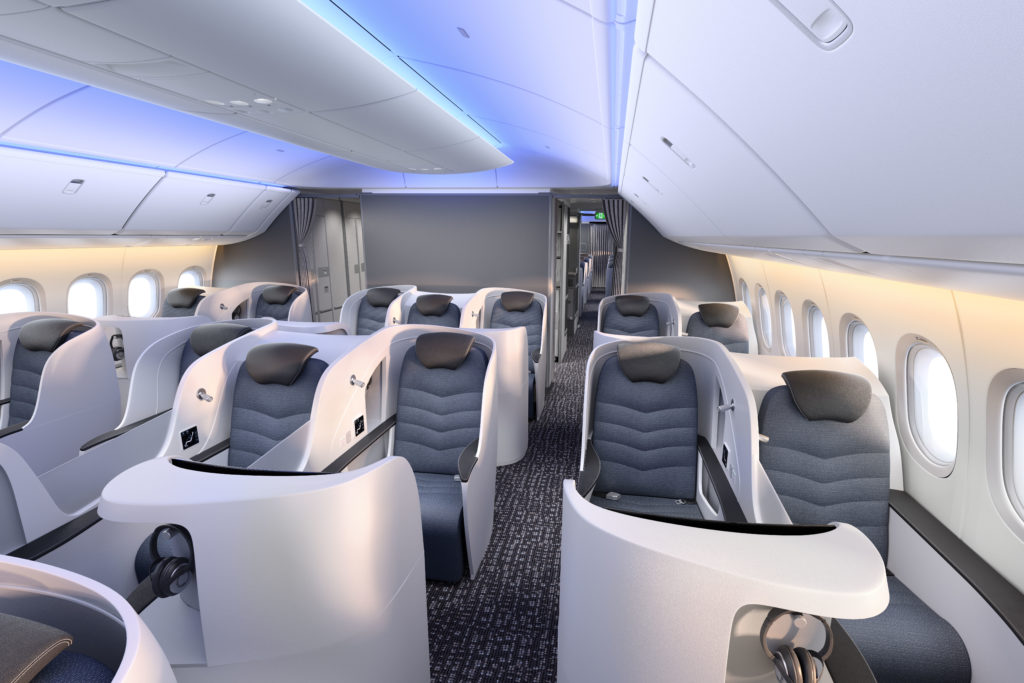
A Boeing concept for a seven-abreast business class. Each seat in this LOPA has direct aisle access
“ We anticipate various airlines flying any and all potential configurations that are out there. From a general trend perspective, we know that some airlines will have full first class on this aircraft. We also know that airlines will have premium economy, as that is the fastest growing cabin trend that we’ve seen, so it will be there for sure,” says Craver.
“I would anticipate that in the coming years there will probably be new alternatives that are created and installed by airlines. There is no limitation – I think that’s probably one of the best things about B777X: the wide twin-aisle cabin gives a lot of space for airlines to do a lot of different things.”
A grand entrance
Whatever class passengers are flying, they are in for a grand entrance to the B777X. Boeing’s research has found that entrance zones are an important part of the experience, as Wilcynski explains: “Our research and preparation for the 777X actually served to reinforce our discoveries during the 787 development. For instance, passengers want a distinct break from the stressful airport experience upon entering the passenger cabin, with welcoming architectural forms and lighting.”
This calming feel will be provided by the vaulted entryways at Door 2, which can be specified, regardless of galley positioning. The domed entry on the Dreamliner wasn’t always possible, depending on galley layout, but that issue was has been addressed with the B777X so that regardless of where the galleys are in the galley flex zone at Door 2, there is the ability to create what Craver describes as “a very wonderful and grandiose entranceway”. He adds that there are options in the space for airlines to be very creative.
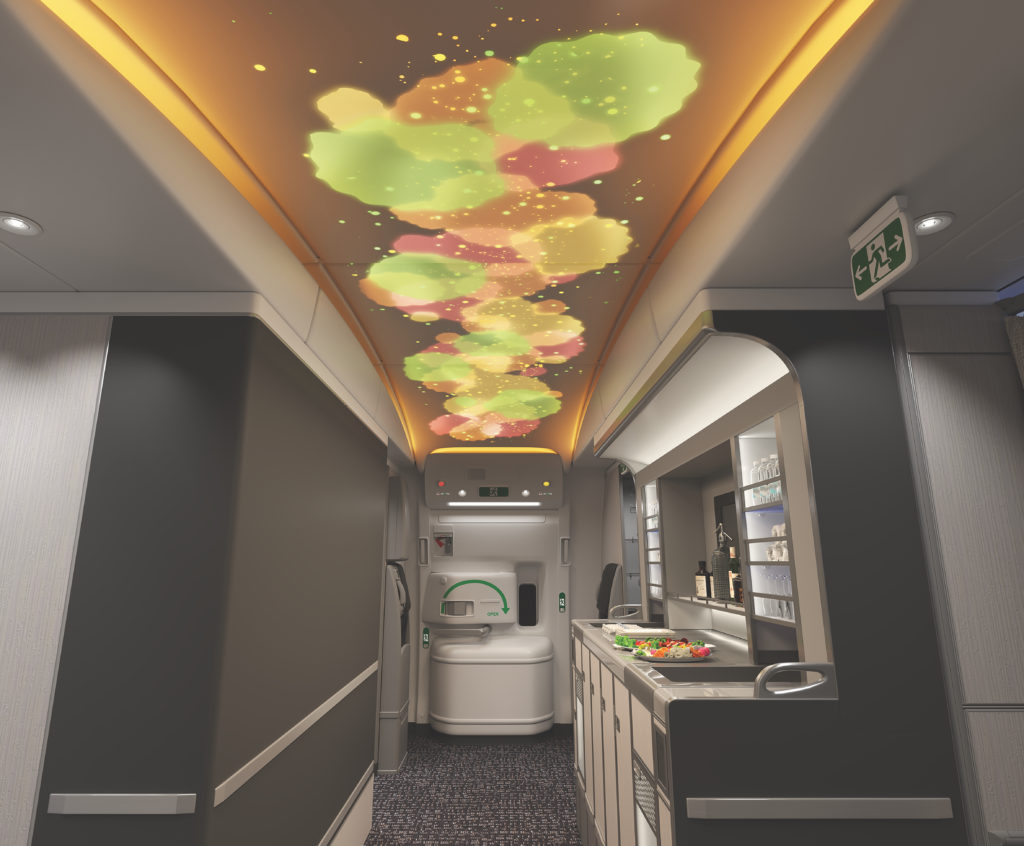
Could a further creative option be passenger spaces below the main deck? Wilcynski says only, “We have looked at – and continue to look at – the possibility of providing access to passengers, and the technical requirements for accommodating inflight use.”
It would be exciting to see the B777X passenger experience extend below decks, offering even more scope for airline brands to express and differentiate their brand, but this aircraft opens up new design opportunities for more airlines. As Emery says, “We’ve placed into the market something that really allows airlines to have the differentiation that they’ve wanted for a long time.”
Technical specs
There are initially two variants of the B777X on offer: the B777-8 and the longer B777-9, with potential for a stretched 450 passenger B777-10X if there is market demand.
B777 – 8
List Price: US$360.5m
Seats (two class) 350-375
Range 8,700 nmi (16,110km)
Length 70m (229ft)
Cabin width 235in (597cm)
B777 – 9
List Price: US$388.7m
Seats (two class) 400-425
Range 7,600 nmi (14,075km)
Length 77m (252ft)
Cabin width 235in (597cm)
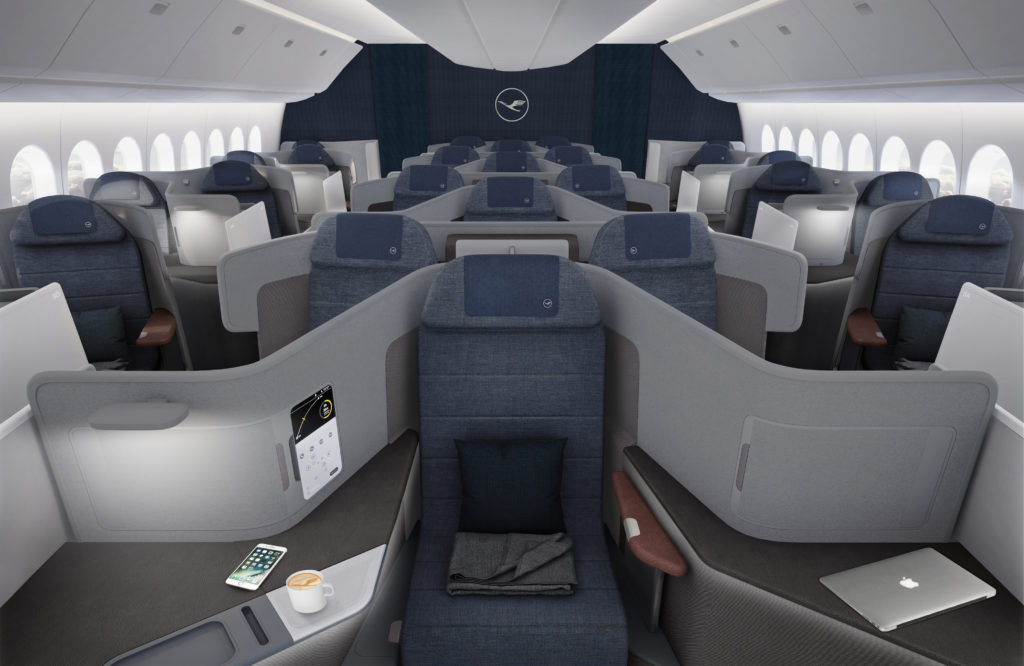
Lufthansa has revealed its plans for the B777X business class, which include a ‘throne’ seat. This distinctive seat is due to launch in 2020, and more than 500 people have been asked for feedback on its comfort levels
Bonus content:
Multicultural research
Boeing has been keen to point out that it conducted multicultural research during the B777X cabin design process, as well as learning how to take passengers’ deep psychological needs into account to find ways of increasing the sense of spaciousness. So what did this involve?
Blake Emery explains, “Because a commercial airplane is a truly global product, you need to understand how the product is perceived everywhere. You don’t want to design a cabin according to the values of only one culture, so our designs are based on our extensive research into the unarticulated needs of many cultures.
“In our research, we discovered some culturally specific values that may be useful to an airline wanting to brand based on their culture, but were not universal. We made a strategic decision to design in ways that incorporate only those values all cultures can appreciate.
“For example, it turns out that every culture has a slightly different perception of cleanliness, yet all cultures appreciate cleanliness. So our cabin designs take this into consideration, especially through material choices.”
Retrofit options?
The B777X cabin designs may make some airlines’ existing B777s feel a little dated. Will there be retrofit packages available to make a more consistent offer?
Kent Craver states, “On our services side, we’re always looking at opportunities to retrofit options, so those processes are in the works and I’m confident that if an airline wanted to retrofit their existing B777-300 fleets with some of the amenities that we’re rolling out with the B777X, we could come up with a solution for them.”
A pleasant climate
A new air nozzle design for the passenger cabins has been designed to improve airflow with reduced noise, which will make it easier to control temperature in the cabin and to achieve a uniform temperature throughout.
“The temperature inside the cabin is a challenging issue because you have passengers who are relatively passive and not moving, and you have flight attendants who are working their tails off,” says Blake Emery. “And so you’ve got a potential situation where passengers could be cold and flight attendants could be warm, all in the same cabin temperature. The airflow through the nozzle system is specifically designed to ameliorate this.”
The electrochromic window option also helps control cabin temperature.
Invisible speakers
The B777X will be a quieter passenger experience than the B777, achieved through measures such as sidewall insulation with better noise absorption properties, a redesigned cabin airflow system with more air nozzles running at lower velocities and thus lower noise, and a new, quieter nacelle design for the high bypass ratio engines.
However, minimizing aircraft noise is not an ultimate goal, as Kent Craver explains: “At Boeing we’re big believers based on research that it’s not about sound level: it’s about sound quality. There is a certain level of sound masking that is desirable so you’re not hearing doors closing and other passengers’ conversations.”
A feature that benefits sound quality in the cabin, as well as aesthetics, is what Boeing has provisionally named the ‘invisible speaker’. With this technology the ceiling panels themselves function as speakers, with enhanced audio quality and no speaker grills to interrupt the clean lines.
There are other reasons for the invisible speakers, but Blake Emery is keen to keep them confidential. “There are actually a number of reasons why we have moved to this technology, most of which we won’t divulge. The reason is that we really like it when the competition tries to copy what we’ve done without understanding why we did it. There are certain things that we just don’t talk about because that works to our advantage.”
What we do know is that, as with every other cabin feature, the speaker forms part of the holistic Sky Interior design philosophy. The invisible speaker helps the ceilings serve as a clean, blank canvas for the different scenes and experiences provided by the cabin lighting system.
The ABC of cabin design

PJ Wilcynski, Boeing’s payloads chief architect, has three guiding principles for designing a great passenger experience.
Airplanes for people. “Always focus on people, the people that come into contact with the airplane. We always design for the full range of passengers and crew.
By design. “We don’t just do things because they look good. It’s by design – through research, testing and design we know a feature will provide value to passengers and crew. For example, the B777X architecture was tested with 4,000 people to assure their sense of spaciousness in the passenger cabin.”
Connected to the sky. “Regardless of the trials and tribulations in the terminal, when passengers get on the airplane the flight experience is still magicical, still special. That’s what it’s all about – flight getting people together.”
Dimmable windows
The optional electronically dimmable windows (EDW) of the B777X are a newer generation than those found on the B787, capable of eliminating more than 99.999% of visible light at twice the darkening speed and reducing the load on the air-conditioning systems. The B777X system has been designed with centralized control, allowing flight crew to set specific lighting scenarios for day- or night-time flight without having to reach over passengers to access the control button.
According to Gentex, the EDW supplier, the units will feature a thin-film coating for elimination of harmful IR and UV light, and low maintenance and operation costs.
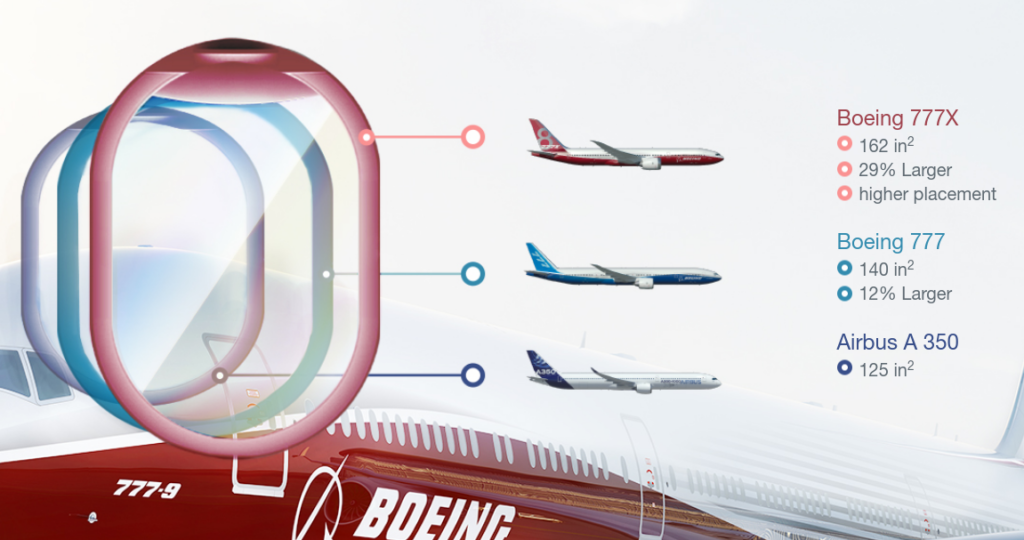
A comparison between aircraft window sizes
EDWs are an electrochromic-based sunlight and heat control system consisting of an electrochromic gel sandwiched between two thin glass panels that darken or lighten in response to electricity – whether activated from the personal control fitted under the window or a crew panel. A low-voltage electric current is passed through conductive coatings and across the glass panels to induce an electrochemical reaction in the gel that causes it to darken. Removing the voltage lets the gel return to its natural, transparent state.
Emirates IFEC
One of the first IFEC announcements for the program is that Thales has signed an agreement to equip Emirates’ 150-strong B777X fleet on order, arriving from 2020. The deal is for the latest generation of broadband inflight connectivity using Inmarsat’s GX Global Network, and for a co-developed version of the Avant IFE system.
According to Thales, it will be the first IFE system provider to equip the B777X platform, and the contract is the result of Thales’ commitment to strengthening its presence in Dubai. In support of Emirates’ long-term ambitions, Thales is setting up Discovery Dubai – a custom innovations centre for the passenger experience – in the United Arab Emirates. Managed by Thales, the centre will enable Emirates teams to develop and shape their future passenger engagement initiatives and programs. Thales also plans to set up a repair centre to provide operational support and services to Emirates.
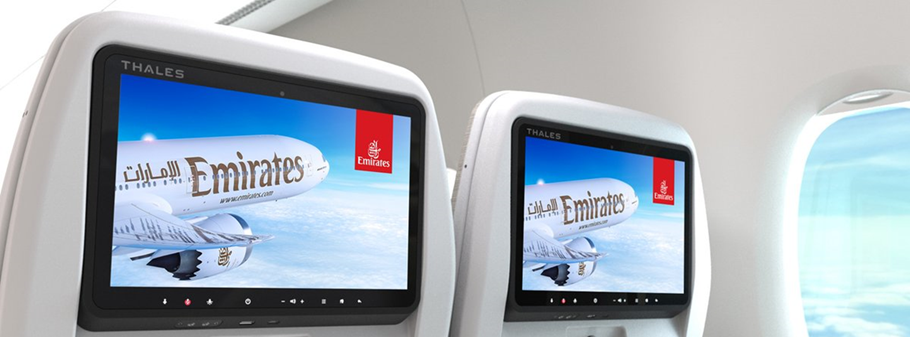
Cabin Services System
Panasonic Avionics has been selected to supply the Cabin Services System (CSS) on the B777X, extending its supply deal for CSSs on the B787 and B747-8i. Panasonic’s CSS is a scalable, database driven, Ethernet-based network that provides core cabin functions such as passenger address, cabin interphone and environmental controls. CSS directly integrates with external subsystems such as cabin lighting and other aircraft member systems across the airframe networks, including the IFEC systems.







